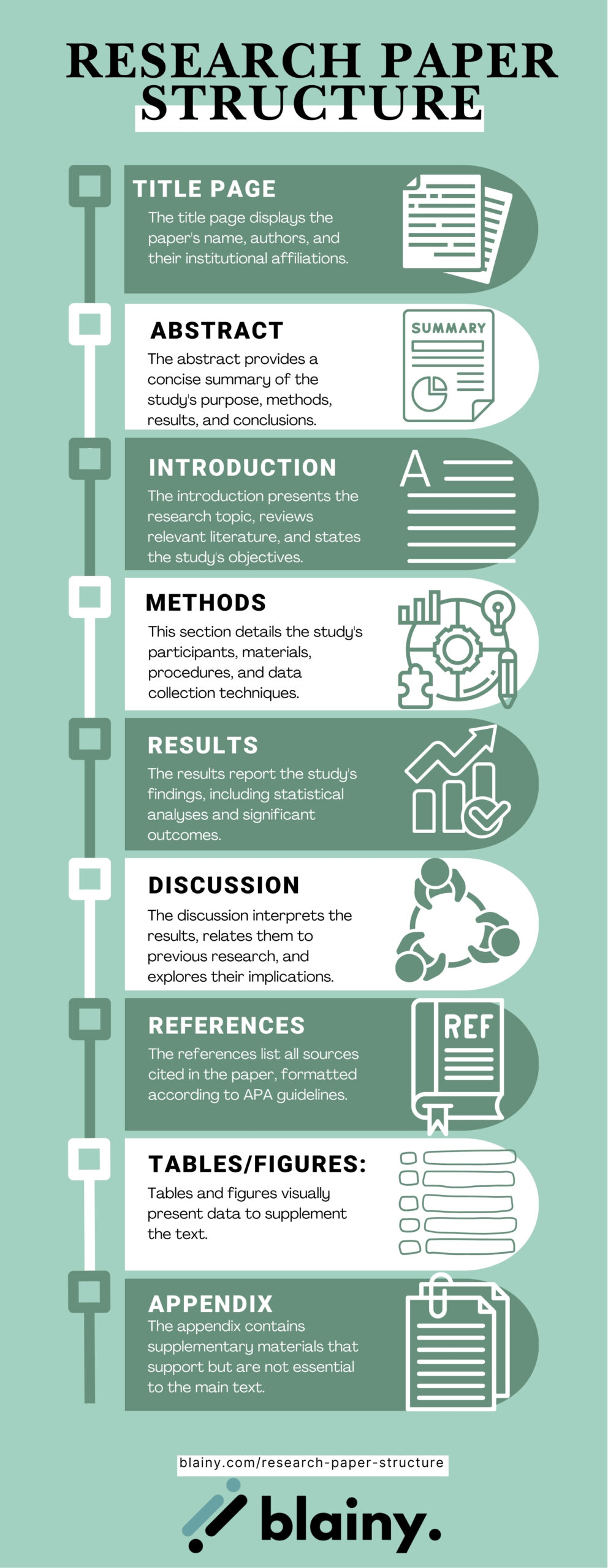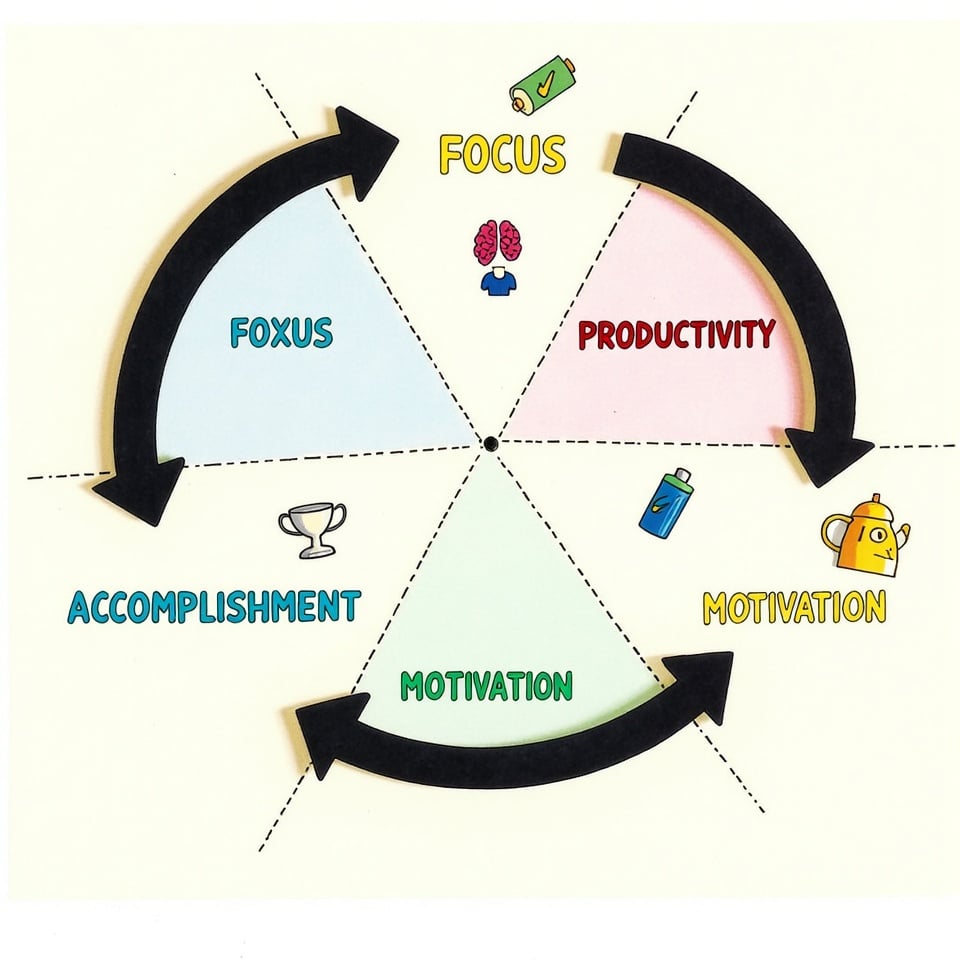When you’re writing a research paper, it’s easy to get overwhelmed. But having a clear plan can make all the difference. That’s where understanding the research paper structure comes in.
A good structure helps you organize your ideas and present them in a way that makes sense. In this article, we’ll explore the different parts of a research paper, from the introduction to the conclusion. We’ll also look at how Blainy can help with the writing process.
Table of Contents
Major sections of a research paper
A research paper has several important parts that work together to help you share your ideas and findings. Knowing what these parts are and how they fit together is essential for writing a clear and effective paper.

Let’s take a closer look at the different sections of a research paper, from the title page to the appendix. Each part has a special job to do, and they all work together to help you present your research in a way that makes sense.
Title page
The title page is the first thing people see when they read your research paper. It’s like the cover of a book, and it should give readers an idea of what your paper is about.
A title page usually includes:
- The title of your paper (make sure it’s short and clear)
- Your name and the names of anyone who helped you with the paper
- The name of your school or organization
- A shorter version of your title (called a running head) and the page number
Sometimes, you might also include a note that thanks people who helped you with your research or provided funding.
The title page is important because it gives readers the basic information they need to know about your paper.
Abstract
After the title page, comes the abstract. This is a short summary of your research paper that tells readers what it’s about.
An abstract is usually around 150-250 words long and gives readers a sneak peek into your study. It should include:
- The main question you’re trying to answer
- A brief description of how you did your research
- The most important things you found out
- What you concluded from your research
The abstract is like a trailer for your paper. It helps readers decide if they want to read the whole thing. So, make sure to keep it short and to the point. Don’t include any extra details or references. Just give readers a clear idea of what your research is about and what they can expect to learn.
Introduction
The introduction is like the beginning of a story. It sets the scene and helps readers understand what your research paper is about.
A good introduction should:
- Introduce the topic you’re studying
- Explain why it’s important
- Give some background information
- Ask a question or make a guess about what you think you’ll find out
- Tell readers what to expect from the rest of the paper
The goal of the introduction is to grab the reader’s attention and make them want to keep reading. You want to show that you know what you’re talking about and that your research is important.
Think of the introduction like a map. It starts with a big picture and then zooms in on the specific area you’re studying. It helps readers follow along and understand what you’re trying to figure out.
Try: Blainy Introduction Generator
Related reading: How to develop a conceptual framework?
Literature review
When you’re doing research, it’s like joining a big conversation. Lots of other people have already talked about your topic, and you need to know what they’ve said.
The literature review is where you summarize what others have found out about your topic. You read what they’ve written, and then you write about it in your own words. You’re looking for:
- What do we already know about this topic?
- What don’t we know yet?
- Are there any disagreements or mysteries that need to be solved?
By doing this, you’re showing that you know what you’re talking about and that your research is important. You’re also explaining why your study is needed and how it fits into the bigger picture.
Think of the literature review like a story that sets the stage for your research. You’re telling the reader what’s already happened, and then you’re going to tell them what you found out. It’s like adding a new chapter to a book that’s already been written.
Try: Blainy Literature Review Generator
Methods
When you’re doing research, you need to explain how you did it. This is so that others can understand what you did and even repeat it if they want to.
In the Methods section, you should answer the question: “What did you do?” You should include:
- Who or what you studied (like people, animals, or plants)
- How you designed your study
- What materials you used
- What steps you took to get your results
If you did lots of different experiments, you might need to break this section up into smaller parts. The important thing is to be clear and precise.
Don’t include extra details that aren’t important, but make sure you include everything that is important. This section shows that you know how to do research and that you thought carefully about how to answer your question.
Think of the Methods section like a recipe. You’re telling the reader exactly what you did, so they can follow along and get the same results.
Related reading: How to write a research brief?
Results
This is the exciting part of your research paper where you share what you discovered! In the Results section, you simply report what you found, without trying to explain what it means.
Start by telling the reader what data you collected and how you looked at it. If you did lots of different experiments, you might need to break this section up into smaller parts.
Using tables and pictures can really help make your results clear. It’s like showing a graph of how your favorite sports team did over the season – it’s easier to understand than just reading a list of numbers.
Remember, the goal of this section is to just share your findings. Don’t try to explain what they mean yet – that comes next. Just focus on presenting your results in a clear and simple way.
Think of the Results section like a report card. You’re just showing what you got, without explaining why you got it. The explanation comes later!
Discussion
Now that you’ve shared your results, it’s time to explain what they mean. In the Discussion section, you get to talk about what you found out and why it’s important.
Start by summarizing the main things you discovered. Then, explain how those findings answer your research question or help solve the problem you were trying to solve.
Think about what your results mean for the bigger picture. How do they fit in with what others have already learned about this topic? What do they add to our understanding?
It’s also important to be honest about any weaknesses in your study. What could you have done better? What questions are still unanswered? This helps others who might want to build on your research.
Remember to connect your discussion back to what you learned from others earlier in your research. Show how your findings fit in with what they already knew.
The Discussion section is like the final chapter of a book. You’re wrapping up the story and explaining what it all means. It’s a chance to show how your research contributes to the bigger conversation and what we can learn from it.
References
When you write a research paper, you use information from other people’s work. The References section is where you list all the sources you used, so others can see where you got your information.
This section is very important because it shows that you’re honest and didn’t just make up the information. It also helps others find the same sources if they want to learn more.
When you make your list of references, you need to follow a special format, like a recipe. This format tells you what information to include, like the author’s name, the date they wrote it, and the title of the book or article.
Different types of sources, like books, articles, and websites, have slightly different formats. It’s like having different instructions for different types of puzzles.
Organize your list alphabetically by the author’s last name, like a phone book. Make sure every source you mentioned in your paper is on this list.
Having a good References section shows that you did your research and helps people trust what you’re saying. It’s like showing your work on a math problem – it proves you didn’t just guess the answer!
Check out: Blainy Citation Generator
Tables and Figures
Sometimes, it’s hard to understand a lot of information just by reading about it. That’s where tables and pictures come in. They can help make complex information easier to understand.
Tables are like charts that show numbers and statistics in a neat and organized way. Pictures can be graphs, charts, diagrams, or even photos that help explain what you’re talking about.
When you use tables and pictures in your research paper, make sure to number them and give them a title that explains what they’re about. This helps the reader know what they’re looking at.
Usually, tables and pictures go on separate pages at the end of your paper, after the References section. But sometimes, you can put them right in the text where you’re talking about them.
The important thing is to make sure you tell the reader where to find the table or picture. You can say something like, “Look at Table 1 to see the results.
Appendix
Sometimes, you might have extra information that’s related to your research, but it’s not really important for understanding the main points. That’s where the Appendix comes in.
The Appendix is like a special section where you can put extra details that might be interesting to some readers, but wouldn’t fit well in the main part of your paper. This could be things like:
- A detailed explanation of how you did your research
- Raw data that you used to get your results
- Complicated calculations that you did to get your answers
- Extra analysis that supports your findings
When you’re deciding what to put in the Appendix, think about what might be helpful to readers who want to learn more about your research.
Each Appendix should have a label (like Appendix A or Appendix B) and a title that explains what it’s about. If you have multiple appendices, list them in the order you mention them in your main paper.
You don’t always need an Appendix, but it can be really helpful if you have a lot of extra information that you want to share. And the best part is, the Appendix doesn’t count towards your main word count, so you can add extra information without making your paper too long!
Why it is important to maintain a research paper structure?
When you write a research paper, it’s like building a house. You need to follow a plan so that it’s strong and easy to understand.
Having a good structure helps your paper in many ways. First, it makes it easier to read and understand. When you follow a standard format, like a recipe, you’re helping your readers find the information they need quickly.
Imagine you’re looking for a specific book in a library. If the books are organized in a way that makes sense, you can find what you’re looking for fast. It’s the same with a research paper. When it’s well-organized, readers can find what they need easily.
Using a standard structure also helps people from different fields understand each other. It’s like speaking a common language. When you follow a format that everyone knows, like APA or MLA, you’re making it easier for others to understand your work.
A good structure also shows that your research is solid and trustworthy. Each part of the paper has a job to do. For example, the methods section shows that you did your research in a way that others can repeat. The literature review shows that you know what you’re talking about.
Having a plan also helps you write your paper. It’s like having a map to follow. You can make sure you cover all the important points and don’t forget anything.
When other people review your paper, a good structure makes it easier for them to see if you did a good job. They can find what they’re looking for quickly and see if you covered all the important points.
Finally, a well-structured paper is easier to find and use. It’s like having a label on a file folder. When you follow a standard format, you’re making it easier for others to find and use your work.
So, remember, having a good structure is important for writing a research paper. It helps your readers, it helps you, and it makes your paper more useful to others.
Use Blainy to create an article outline
When you’re writing a research paper, it can be hard to know where to start. That’s where Blainy comes in. It’s a tool that can help you create an outline for your paper.
To use Blainy, just type in your topic or main idea. The AI will then create an outline just for you. This outline will have all the main sections you need, like Introduction, Literature Review, and Conclusion.
One of the cool things about Blainy is that it can even help you come up with ideas for your research paper. If you’re not sure what to write about, the AI can suggest some topics for you.
The outline that Blainy creates is like a roadmap for your paper. It helps you make sure you cover all the important points and that your ideas flow logically.
You can also change the outline to fit your needs. If you need to add or remove sections, you can do that easily. This is helpful if you’re writing in a specific format, like APA or MLA.
Blainy can even help you figure out how long each section should be. This way, you can make sure you’re giving each part of your paper the attention it needs.
Using Blainy to create an outline doesn’t just save you time – it also helps you think more critically about your research. It makes you think about things you might have missed, like counterarguments or other areas to explore.
So, if you’re struggling to create an outline for your research paper, try using Blainy. It’s a helpful tool that can make the writing process easier and more fun!
Try Blainy Outline Generator Now!
Bottom line
When you write a research paper, it’s like building a house. You need a strong foundation so it doesn’t fall apart. A good structure is that foundation. It helps you communicate your ideas clearly and in a way that makes sense.
Using a standard format, like a recipe, helps you organize your thoughts and ideas. It’s like following a map to get to your destination. Tools like Blainy AI can even help you create an outline, making it easier to write your paper.
Remember, a good structure is important because it helps others understand what you’re saying. It also makes it easier for them to review your work and see if it’s good or not. And, it helps your research make a bigger impact.
Whether you’re just starting out or you’re an expert, following a clear structure is the key to writing a great research paper. It’s like having a secret ingredient that makes your work stand out.
So, always remember to use a good structure when writing a research paper!
Frequently asked questions
What is the structure of a research paper?
The structure of a research paper typically follows a standardized format that includes:
- Title Page: Contains the paper’s title, author’s name, institutional affiliation, and sometimes an author’s note.
- Abstract: A brief summary of the entire paper, usually 150-300 words.
- Introduction: Presents the research question, provides background information, and states the paper’s purpose.
- Literature Review: Summarizes and analyzes relevant previous research on the topic.
- Methodology: Describes how the research was conducted, including participants, materials, and procedures.
- Results: Presents the findings of the study, often including statistical analyses.
- Discussion: Interprets the results, discusses their implications, acknowledges limitations, and suggests future research directions.
- Conclusion: Summarizes the main points and restates the significance of the findings.
- References: Lists all sources cited in the paper, formatted according to the required citation style (e.g., APA, MLA).
- Appendices (if necessary): Contains supplementary material that doesn’t fit in the main body of the paper.
What are the 5 parts of the research paper?
While research papers can vary in their specific structure, the five essential parts of a research paper are:
- Introduction: Sets the context for the research, presents the research question or hypothesis, and outlines the paper’s significance.
- Literature Review: Examines existing research related to the topic, identifying gaps or controversies that the current study addresses.
- Methodology: Explains how the research was conducted, detailing the research design, data collection methods, and analysis procedures.
- Results: Presents the findings of the study, often using tables, graphs, or other visual aids to support the text.
- Discussion: Interprets the results, relates them back to the research question and existing literature, discusses implications, acknowledges limitations, and suggests areas for future research.







